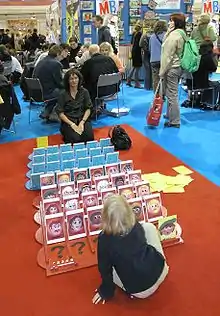Guess Who?
Guess Who? is a two-player character guessing game created by Ora and Theo Coster, also known as Theora Design, that was first manufactured by Milton Bradley in 1979 and is now owned by Hasbro. It was first brought to the UK by Jack Barr Sr. in 1982. The classic edition is currently being produced by Winning Moves.
.jpg.webp)
Gameplay
Each player starts the game with a board that includes cartoon image of 24 people and their first name with all the images standing up. Each player selects a card of their choice from a separate pile of cards containing the same 24 images. The object of the game is to be the first to determine which card one's opponent has selected. Players alternate asking various yes or no questions to eliminate candidates, such as "Does your person wear glasses?" The player will then eliminate candidates (based on the opponent's response) by flipping those images down until only one is left. Well-crafted questions allow players to eliminate one or more possible cards. Questions might include:
Editions

Special editions which have different faces have been released, including Star Wars, Marvel Comics and Disney. There are smaller, "travel" editions which have only 20 different faces. In 2008 and 2010, extra and mix and match games were released. A computer game based on the series was released in 1999 by Hasbro Interactive.
Advertising
In the United States, advertisements for the board game often showed the characters on the cards coming to life, and making witty comments to each other. This caused later editions of such ads to carry the spoken disclaimer line "game cards do not actually talk" in order to meet Federal Trade Commission advertising guidelines requiring full disclosure of toy features unable to be replicated with the actual product.[1]
Strategy
Popular belief is that a binary search is the most efficient approach to the game, where each question halves the number of possible identities.[2] This can be applied by asking complex questions - such as "Does your character have red hair, or glasses, or a big nose?" - where a yes or a no eliminates exactly half of the remaining characters.[3] Such a strategy takes only four questions to reduce the field to three people, giving the fifth question a 50/50 chance of identifying the opponent's character.
The game was strongly solved by Mihai Nica in 2016.[2] Refuting the binary search approach, Nica's research showed higher rates of success for a strategy of making "bold plays" to catch up with the other player. Using this method, the first player has a 63% chance of winning under optimal play by both sides.
Reception
The Blaze noted that the major perk of playing the game is "watching your opponent [watch you] knock down several of the flipped up tiles with faces on them, putting you well on your way to guessing his or her main character".[4]
Criticism of lack of diversity
Modern commentators have noted a bias toward white and male characters in Guess Who. In 2012, a six-year-old girl wrote to Hasbro asking why there were only five female characters to choose from, against nineteen male. Hasbro's response noted that each characteristic in the game – such as wearing glasses, or having red hair[5] – was based on a numerical equation, and deliberately appeared exactly five times. The child's parent asked "Why is female gender regarded as a 'characteristic', while male gender is not?"[6]
Despite the company's claim that players should "draw attention away from using gender or ethnicity as the focal point", the child's mother pointed out that physical differences of humans was the whole point of the game.[7] The Huffington Post noted that one source had deemed the remarks "tone-deaf".[8] Blogger Avital Norman Nathman suggested that the decision to include five women in the game wasn't a conscious choice, which she argues is a problem in itself.[8] Some editions of the game since the early 2000s have included more women.[9]
The original version of Guess Who featured only one non-white character – Anne, who was redrawn in a subsequent edition as a white woman. More recently, Hasbro has redesigned the board to feature a more racially diverse set of people.[10]
People's names
| Name | Also known as | Introduced | Retired | Notes |
|---|---|---|---|---|
| Al | Alfred, Stephen | 1980 | — | |
| Amy | — | 2018 | — | |
| Anita | — | 1980 | 2018 | |
| Anne | — | 1980 | 2018 | Absent from 1998-2002 |
| Ben | — | 2018 | — | |
| Bernard | — | 1980 | 2018 | |
| Betty | — | 1999 | 2001 | |
| Bill | Phillipe | 1980 | 2018 | |
| Carmen | — | 2002 | — | |
| Charles | Hans | 1980 | 2018 | |
| Claire | Sarah | 1980 | 2018 | |
| Daniel | — | 2018 | — | |
| David | Luke, Lucas | 1980 | — | |
| Emma | — | 2018 | — | |
| Eric | — | 1980 | — | |
| Farah | — | 2018 | — | |
| Frank | — | 1980 | 1998 | |
| Gabe | — | 2018 | — | |
| George | Joe | 1980 | 2001 | |
| Herman | — | 1980 | 2018 | |
| Holly | Kaitlin | 1999 | 2018 | |
| Joe | — | 1980 | — | Absent from 1998-2002 |
| Jordan | — | 2018 | — | |
| Katie | — | 2018 | — | |
| Laura | — | 2018 | — | |
| Leo | — | 2018 | — | |
| Lily | — | 2018 | — | |
| Liz | — | 2018 | — | |
| Maria | — | 1980 | 2018 | |
| Max | Theo | 1980 | 2018 | |
| Mia | — | 2018 | — | |
| Mike | — | 2018 | — | |
| Nick | — | 2018 | — | |
| Olivia | — | 2018 | — | |
| Paul | — | 1980 | 2018 | |
| Peter | — | 1980 | 2018 | Absent from 1998-2002 |
| Philip | Max, Mario | 1980 | 2018 | |
| Rachel | — | 2018 | — | |
| Richard | Roger | 1980 | 2018 | |
| Robert | — | 1980 | 1999 | |
| Sally | Sophie | 1999 | 2018 | |
| Sam | Charles | 1980 | — | |
| Sofia | — | 2018 | — | |
| Susan | — | 1980 | 1998 | |
| Tom | Albert, Daniel | 1980 | 2018 | |
| Victor | — | 1999 | 2018 |
References
- "Guess Who? Retrospective". www.toy-tma.com. Retrieved 2018-05-26.
- Optimal Strategy in "Guess Who?": Beyond Binary Search by Mihai Nica.
- Allan, Patrick (20 November 2015). "Almost Always Win the Game Guess Who With This Math-Based Strategy". Lifehacker. Retrieved 19 November 2020.
- Liz Klimas. "Guess Who's Calling Out Hasbro for Gender Inequality: A 6-Year-Old (Read Her Letter)". The Blaze. Archived from the original on 2017-03-09.
- "Hasbro: Being a boy is normal, being a girl is a "characteristic"". www.newstatesman.com. Retrieved 10 October 2020.
- "Guess Who's sexist? Classic board game's gender bias leaves". The Independent. 17 November 2012. Retrieved 10 October 2020.
- "Six-Year-Old Girl (Board) Gamer Calls out Guess Who? on Its Gender Inequality; Hasbro's Response is Both Hilarious and Awful".
- "Jennifer O'Connell, Mom, And 6-Year-Old Daughter Ask Hasbro About Gender Inequality In 'Guess Who?'". The Huffington Post. 21 November 2012.
- Adam Sherwin (17 November 2012). "Guess Who's sexist? Classic board game's gender bias leaves". The Independent.
- Laura Vitto (3 July 2013). "5 Depressing Facts About Your Favorite Childhood Games". Mashable.
